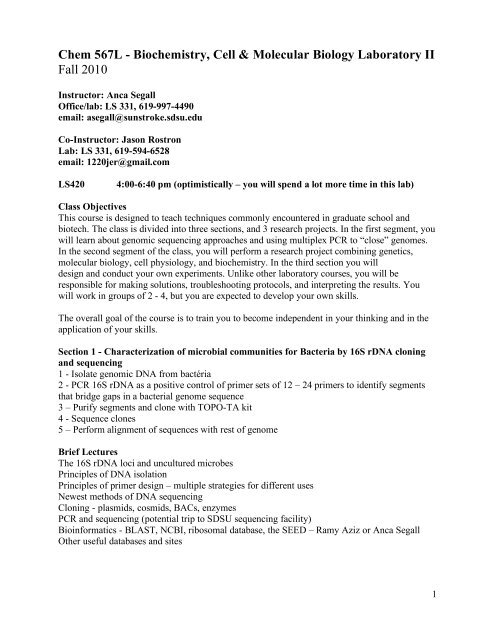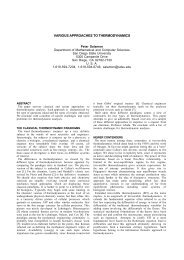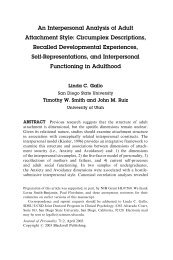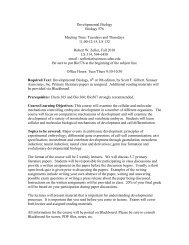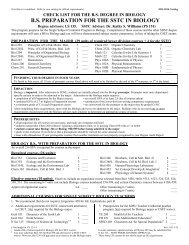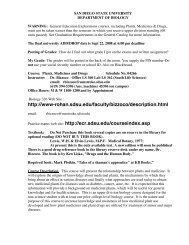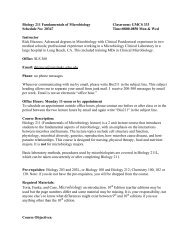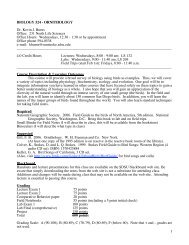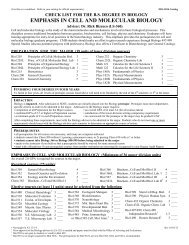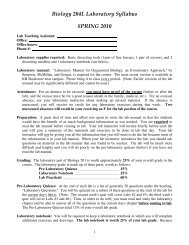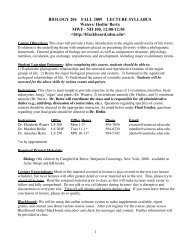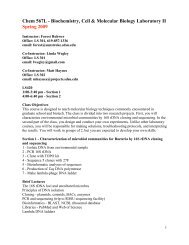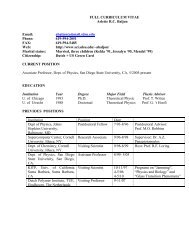Biol 567L: Biochem, Cell & Mol Bio Lab II
Biol 567L: Biochem, Cell & Mol Bio Lab II
Biol 567L: Biochem, Cell & Mol Bio Lab II
Create successful ePaper yourself
Turn your PDF publications into a flip-book with our unique Google optimized e-Paper software.
Chem <strong>567L</strong> - <strong><strong>Bio</strong>chem</strong>istry, <strong>Cell</strong> & <strong>Mol</strong>ecular <strong><strong>Bio</strong>l</strong>ogy <strong>Lab</strong>oratory <strong>II</strong><br />
Fall 2010<br />
Instructor: Anca Segall<br />
Office/lab: LS 331, 619-997-4490<br />
email: asegall@sunstroke.sdsu.edu<br />
Co-Instructor: Jason Rostron<br />
<strong>Lab</strong>: LS 331, 619-594-6528<br />
email: 1220jer@gmail.com<br />
LS420<br />
4:00-6:40 pm (optimistically – you will spend a lot more time in this lab)<br />
Class Objectives<br />
This course is designed to teach techniques commonly encountered in graduate school and<br />
biotech. The class is divided into three sections, and 3 research projects. In the first segment, you<br />
will learn about genomic sequencing approaches and using multiplex PCR to “close” genomes.<br />
In the second segment of the class, you will perform a research project combining genetics,<br />
molecular biology, cell physiology, and biochemistry. In the third section you will<br />
design and conduct your own experiments. Unlike other laboratory courses, you will be<br />
responsible for making solutions, troubleshooting protocols, and interpreting the results. You<br />
will work in groups of 2 - 4, but you are expected to develop your own skills.<br />
The overall goal of the course is to train you to become independent in your thinking and in the<br />
application of your skills.<br />
Section 1 - Characterization of microbial communities for Bacteria by 16S rDNA cloning<br />
and sequencing<br />
1 - Isolate genomic DNA from bactéria<br />
2 - PCR 16S rDNA as a positive control of primer sets of 12 – 24 primers to identify segments<br />
that bridge gaps in a bacterial genome sequence<br />
3 – Purify segments and clone with TOPO-TA kit<br />
4 - Sequence clones<br />
5 – Perform alignment of sequences with rest of genome<br />
Brief Lectures<br />
The 16S rDNA loci and uncultured microbes<br />
Principles of DNA isolation<br />
Principles of primer design – multiple strategies for different uses<br />
Newest methods of DNA sequencing<br />
Cloning - plasmids, cosmids, BACs, enzymes<br />
PCR and sequencing (potential trip to SDSU sequencing facility)<br />
<strong>Bio</strong>informatics - BLAST, NCBI, ribosomal database, the SEED – Ramy Aziz or Anca Segall<br />
Other useful databases and sites<br />
1
Practicals<br />
Calibration of pipettors<br />
Solution preparations<br />
Autoclave and plate pouring<br />
PCR<br />
Polyacrylamide gel electrophoresis<br />
TOPO and SLIC cloning<br />
<strong>Bio</strong>informatic analyses of 16S rDNAs<br />
Section 3 - Design and conduct independent research.<br />
You will discuss your ideas for this segment with Anca Segall or Jason Rostron, and get help<br />
with designing an experiment that will give meaningful results. However, you will be expected<br />
to think about and come up with ideas on your own first.<br />
Required Materials:<br />
<strong>Lab</strong> notebook – a normal compositions book will be fine<br />
<strong>Lab</strong> coat<br />
Fine-tip Sharpie<br />
Calculator<br />
<strong>Lab</strong> notebooks:<br />
<strong>Lab</strong>oratory notebooks will be periodically checked as part of your subjective grade (20 points<br />
total). These notebooks can also be used during the practical exams, so it is to your<br />
advantage to do a good job.<br />
Short write-ups and pop quizzes:<br />
Pop quizzes and short write ups will be given throughout the course of the semester on material<br />
already covered and also on new material that you should have read before coming to<br />
class (up to 100 points).<br />
Practical Exams:<br />
You will obtain up to 30 points for the practicals<br />
Write-up of Second section project<br />
This write-up will serve as the practice for the final project report. It is worth 30 pts.<br />
Presentation and write-up of Final Project:<br />
10-12 minute powerpoint presentation AND a report of your independent project (100 points).<br />
Presentations can be done as a group; reports are independent efforts.<br />
Attendance:<br />
You must attend each class meeting. If you miss a class, let me know why and when. If you miss<br />
2 classes you will be dropped or you will fail.<br />
2
Grading Scale:<br />
94 - 100% A 74 - 76% C+ 60 - 63% D<br />
90 - 93.9% A- 70 - 73% C below 60% F<br />
84 - 89.9% B+ 67 - 69% C-<br />
80 - 83% B 64 - 66% D+<br />
77 - 79% B- 60 - 63% D<br />
<strong>Lab</strong>oratory Notebooks:<br />
Notebook Table of Contents: Experiment title, date, and page numbers<br />
Title: State the title of the experiment.<br />
Purpose: State the purpose of the experiment. Why are we doing the experiment?<br />
Data/Calculations/Results: Include all data: figures, tables, calculations, etc. Introduce each<br />
result section.<br />
Discussion/Conclusions/: State any conclusions you have regarding data and why or why not<br />
expected results were obtained. Example: As expected, relatively pure, undegraded RNA was<br />
isolated from mammalian cells as seen in Figure 1, Lanes 1-3, which represent 1, 5 and 10µl of<br />
mammalian RNA, respectively.<br />
Future: I will change X in order to get better results; or, I will do Y to answer the question that<br />
arises from my last experiment.<br />
Tape protocols, disks with data, Post-It notes into your notebook. The main purpose of the<br />
notebook is to be understandable at a latter date....<br />
DO NOT ERASE OR WHITE-OUT MISTAKES; cross out with a line or an X<br />
DO NOT COVER OVER ANY TEXT<br />
Schedule for Fall 2010 (Monday and Wedesdays)<br />
Week 1 - Check in and Starting Quiz<br />
- Autoclave, pour plates with antibiotics<br />
- Genomic DNA isolation<br />
- Pipettors, calibrations, making solutions, and dilution problems<br />
Week 2 – 5<br />
Week 5 – 9<br />
(note overlap)<br />
Week 8 – 9<br />
- First project: closing a genome using multiplex PCR<br />
- Second project, starting with SLiC cloning<br />
- Students will plan and discuss independent projects with instructors<br />
Week 10 – end - Independent (third) project<br />
Last day in lab and check-out: December 8;<br />
Dates for presentations to be determined; all independent 3 rd project reports due December 16<br />
3


